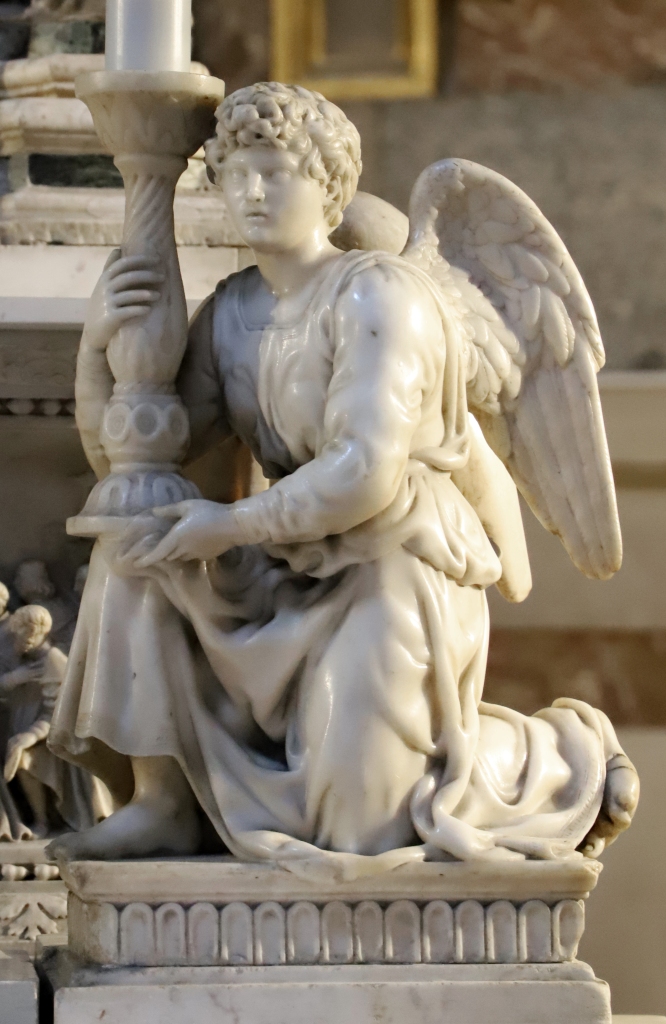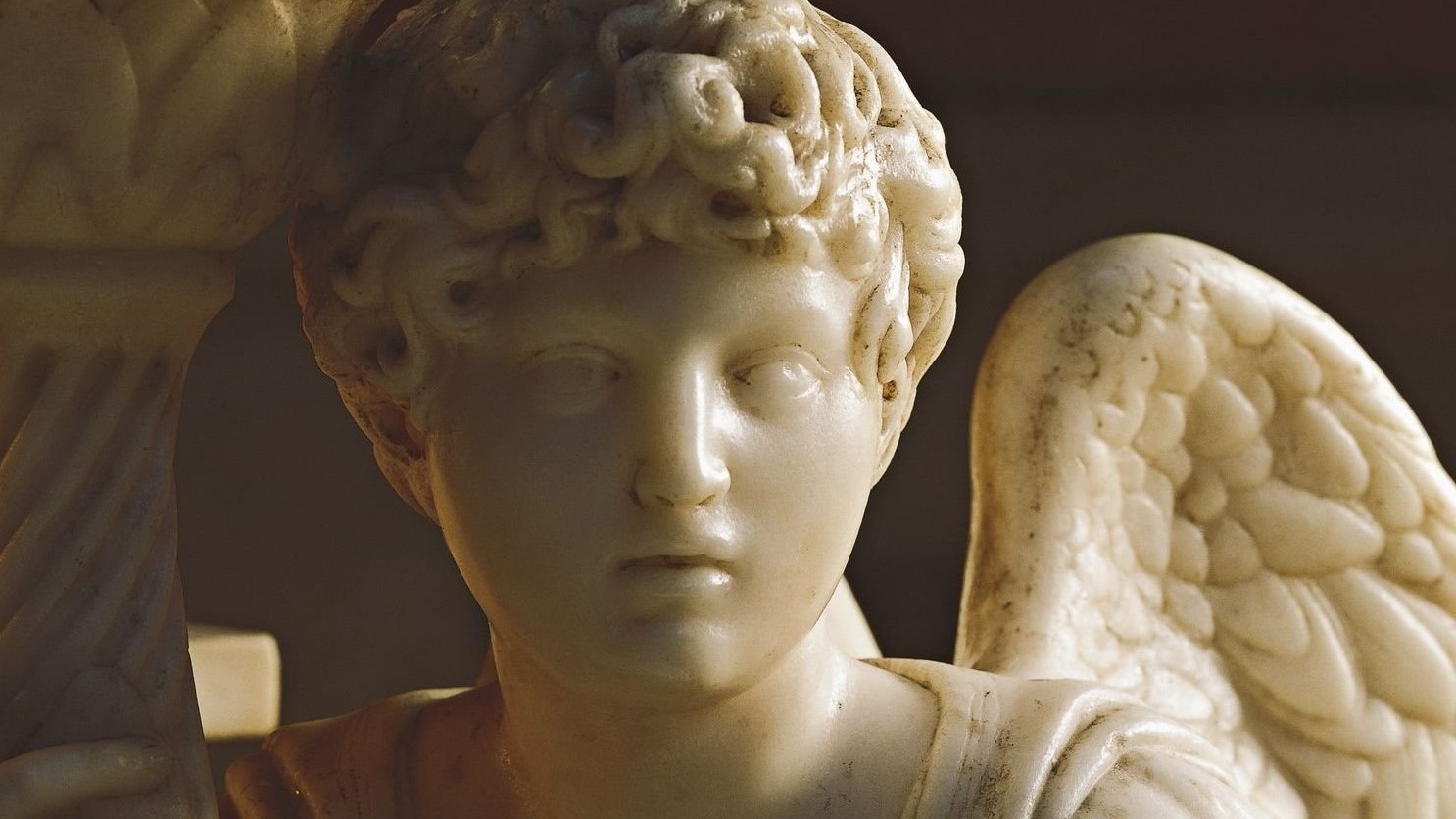Michelangelo Buonarroti, Angel, 1494-5. San Domenico, Bologna.
You would think that no one could hold a candle to Michelangelo – but everyone has to start somewhere, and the young sculptor must have learnt from someone. Indeed, today’s work is an example of the young genius responding – directly and overtly – to someone else’s work, while also enabling the good people of Bologna to burn the candle – or rather, candles – at both ends (in a manner of speaking). It also happens to be a very good example of one of the strengths of sculpture: it can be used for many different things. In this case, it is a candlestick, something that just wouldn’t work with a painting. It is, inevitably, one of the sculptures which will feature this Monday, 13 June, in the second talk in my series Sculpture: Form, Function, Material and Memory. Being week two, we will be looking at the function of sculpture, and asking What is it for? We will look at many of the potential uses of three-dimensional art – besides the ‘merely’ aesthetic, that is – with works varying from fountains to funerary monuments, and from candlesticks to coinage. Today’s work is a good example of this, given that’s its own function is just one element of a sculptural ensemble which in itself fulfils more than one role.

The angel kneels on his left knee, with his right foot firmly planted on the ground. The left is resting on its big toe, bending under the weight at the very edge of a scalloped base. A sizeable candelabrum rests on the angel’s right knee, and is held in place at its base by the left hand, with the right, wrapping round the shaft from behind, about half-way up. The top of the candelabrum is at the same level as the top of the angel’s head. Two wings project behind the figure, and we can see a space carved between the lower section of the candelabrum and the angel’s torso. He wears a long robe which forms full, rounded folds – even though the hem below the raised knee would make it appear very thin. Not only is it very delicately carved, but some of the folds are excavated deeply to create dark shadows. Some of the drapery falls over the base, and even over its edge, making the figure seem more ‘present’ in our space. The angel’s full, round face looks out, turning a little to his left, with slightly parted lips. He has a full head of curly hair piled on top of his head, but cut shorter at the back and sides.

He has a companion – another candle-bearing angel, kneeling on his right knee, with the left foot planted firmly on the ground, and the right resting on a bent toe at the edge of an identical base. The robe is perhaps simpler, and the folds, although similarly rounded, fall more directly downwards. Even so, one crosses the edge of the base in an equivalent way. The delicate hems of the sleeves suggest that this robe was also made from thin fabric. The wings are different, perhaps, but not as different as the face – longer than that of Michelangelo’s angel, more delicate too. This angel’s hair falls in luxuriant curls which spiral down on either side of the face and behind the neck – although as we can’t see the back of the sculpture (the photographs simply don’t exist) we can’t tell exactly how long it is. The hands do not seem to hold the candelabrum so firmly, with the fingers of the right hand merely resting on its base.


When seen side by side these two angels remind me of two very different altar boys, one refined, effete, polite, patient and following all the rules, the other a little bruiser, muscular, chunky even, getting into trouble but getting away with it, and probably there because his mum is a friend of the priest, but he’d really rather be somewhere else. The former is by Niccolò dell’Arca, the latter, Michelangelo. And while most people look to the famous artist’s work as a precursor of his late, great interest in the potential power of the male physique, I should really point out that he carved this sculpture when he was still only 19. He was still learning, and he was learning as fast as he could from Niccolò. The pose of the figure is a deliberate echo, as the less famous master had died leaving the work (after which he was named) incomplete. One of the missing figures was this angel. The pair was meant to kneel at either end of the Arca – the tomb, or shrine – of none other than St Dominic. Hence my suggestion that Michelangelo facilitated the burning of a candle at both ends…

This is the Arca in its entirety, almost a history of Italian sculpture in its own right, with some post-dating both of our angels. St Dominic died in Bologna in 1221, and was canonised thirteen years later. Compare that with St Francis who died five years after Dominic, and was welcomed into the Canon of the Saints within two years – eight years before Dominic. But then he was far friendlier, told good stories, and spoke to the animals. Dominic was more hard-line – and, as I said last week, particularly down on the heretics. Good for the church, some would say, but hardly endearing. As a result almost no one visits his shrine – the Arca – which means you’re bound to get it to yourself – although a friendly Dominican may well extol the good man’s virtues while you’re there.

In 1264 the Dominicans commissioned a sarcophagus from Nicola Pisano, although he was called away the next year, and it was completed by his workshop. The shrine would originally have stood in the middle of a chapel atop a group of caryatids, which are now believed to be dispersed among a number of different museums. The bold, Romanesque, almost classical figures in the scenes from the life of St Dominic (two on each side and one at each end) are set against a gold mosaic background. These scenes are separated by the Madonna and Child and Christ the Redeemer in the centre (front and back respectively) with a saint at each corner. In this detail you can just see the heads of the two angels at either end (bottom left and right).

Between 1469 and 1473 the Arca was remodelled by Niccolò, a sculptor from Puglia, and by this time as well as functioning as a tomb it had also became an altar, with the sculptures on the sarcophagus acting as an altarpiece. Niccolò added the tiled ‘roof’, and topped it with a remarkable superstructure. The four evangelists, in unconventional ‘oriental’ garb, stand on the four corners, with God the Father at the very summit above putti and garlands and any number of extravagant architectonic details. He also intended to carve eight saints to stand on the cornice of the sarcophagus – but only finished five – and two candle-bearing angels – but only managed one. It could be that he continued to work on the project until he died, but by 1494 there were still four figures missing. Nevertheless, it became his defining work. Referred to in documents as Niccolò da Bari and Niccolò d’Antonio d’Apulia, among other names, he is now universally called Niccolò dell’Arca – Nicholas of the Shrine.
So how did Michelangelo get involved? Well, Vasari tells us that, after the death of Lorenzo the Magnificent in 1492, the teenage Michelangelo carried on working for Lorenzo’s son Piero until 1494, when he left Florence abruptly, just weeks before the Medici family were deposed. He went to Bologna, then on to Venice, and then, ‘Being unable to find any means of living in Venice, he went back to Bologna.’ However, he failed to follow regulations, didn’t have the money to pay a fine, and ended up in trouble – a predicament he managed to get out of quite possibly because the Medici had connections in Bologna. Long story short: he carved three of the missing four figures, a great honour given that (a) it was one of the major monuments in Bologna, (b) he was almost totally unknown, and (c) he was not yet 20 when he started. The fourth ‘missing figure’ wasn’t carved until 1539, when it was assigned to Girolamo Cortellini. Before that, though – in 1532 – Alfonso Lombardi had added the predella-like section, the base of which is the same height as the bases on which the angels are kneeling. And centuries later, in 1768, the ensemble as we see it today was finally completed with the addition of the altar frontal, designed by Carlo Bianconi.



What I find fascinating is that Michelangelo was so keen to learn from Niccolò’s example. Although not as long, the hair is every bit as curly, and he attempts to carve each individual whorl just as deeply. He also strives to make the facial features every bit as delicate. Even the drapery (see above) is carved as thinly as possible, and made to flow in the same rounded folds – even if the flow itself is more complex. And yet he can’t quite get there, he can’t quite do it as well as Niccolò. I’d even go so far as to say he can’t hold a candle to him, in terms of delicacy and refinement, at least. But that’s because, ultimately, this is not the direction in which his art would go. From this point on he left delicacy behind, and took on determination, boldness, complexity, the depths of the inner life, torment, and ultimately, terribilità – one of those words it is almost impossible to translate. Indeed, the Mirriam-Webster dictionary online says, ‘an effect or expression of powerful will and immense angry force (as in the work of Michelangelo)’. His work defines the word. Admittedly Wikipedia’s definition is better, although again, somewhat circular: ‘Terribilità, the modern Italian spelling, (or terribiltà, as Michelangelo’s 16th century contemporaries tended to spell it) is a quality ascribed to his art that provokes terror, awe, or a sense of the sublime in the viewer’. We don’t yet see that here, but maybe (just maybe) it is on the way.

And yes, I do ‘prefer’ Niccolò’s angel. But I’m also carrying a torch for the Michelangelo.


Love receiving your emails. Cheeky question – I’m looking at Yellow Christ with my Y6 classes (RE). Can you recommend a good website for art history for children – we’ve looked at other representations of Christ and some of them were really responsive/interested.Thanks. Hope you are both well x
LikeLike
I don’t, as it happens – but I’m sure I know some people who do. I’ll back to you soon!
Both well, thanks – and you?
LikeLike
Not having seen the original, has Michelangelo’s angel’s left foot been damaged or is it the photograph?
Like a new mother counting her newborn’s toes I can only see 4.
LikeLike
I think it’s the photograph – none of them are taken from the right angle to see the foot clearly. But it might have been damaged.
LikeLike